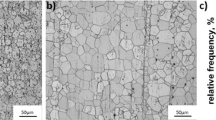Abstract
It is of interest to assess the thermally activated nature of the deformation mechanisms responsible for the anisotropic response of textured Mg alloys, especially in those alloys that do and do not contain rare earth elements. The repeated stress relaxation method in combination with elasto-viscoplastic self-consistent (EVPSC) polycrystal modeling is employed to determine the strain rate sensitivity and true activation volume of samples of textured, polycrystalline Mg alloys, ME10 and AZ31, loaded along different directions in both the hard-rolled (F) and annealed (O) tempers. The results of Haasen plot analyses suggest that a superposition of at least two key mechanisms is responsible for controlling the thermally activated motion of dislocation for both of the alloy types investigated. One has a lower activation volume (solute-dislocation interaction and/or cross-slip), while the other is the ever-present forest dislocation interaction.






Similar content being viewed by others
References
U.F. Kocks, A.S. Argon, and M.F. Ashby, Thermodynamics and Kinetics of Slip, Progress in Materials Science, vol. 19, ed. B. Chalmers, J.W. Christ, and T.B. Massalsk (Oxford: Pergamon Press, 1975), pp. 1–288.
D. Caillard and J.L. Martin, Thermally Activated Mechanisms in Crystal Plasticity (Pergamon Materials Series, Vol. 8 (Amsterdam: Elsevier, 2003).
H. Conrad and W.D. Robertson, Trans AIME 209, 503 (1957).
H. Conrad, L. Hays, G. Schoeck, and H. Wiedersich, Acta Metall. 9, 367 (1961).
A. Couret and D. Caillard, Acta Metall. 33, 1447 (1985).
A. Couret and D. Caillard, Acta Metall. 33, 1455 (1985).
A. Ahmadieh, J. Mitchell, and J. Dorn, Lithium Alloying and Dislocation Mechanisms for Prismatic Slip in Magnesium (No. UCRL-11417 Rev. 2) (Berkeley: California University, Lawrence Radiation Lab, 1965), pp.1–34.
A. Akhtar and E. Teghtsoonian, Acta Metall. 17, 1351 (1969).
A. Akhtar and E. Teghtsoonian, Acta Metall. 17, 1339 (1969).
D.H. Sastry, Y.V.R.K. Prasad, and K.I. Vasu, Curr. Sci. 39, 97 (1970).
P. Lukac and Z. Trojanová, Key Eng. Mater. 465, 101 (2011).
Z. Trojanová, K. Máthis, P. Lukáč, G. Németh, and F. Chmelík, Mater. Chem. Phys. 130, 1146 (2011).
P. Spätig, J. Bonneville, and J.-L. Martin, Mater. Sci. Eng. A 167, 73 (1993).
J.C. Li, Can. J. Phys. 45, 493 (1967).
T. Kruml, O. Coddet, and J.L. Martin, Acta Mater. 56, 333 (2008).
A.H. Cottrell and R.J. Stokes, Proc. R. Soc. Lond. A 233, 17 (1955).
J.J. Bhattacharyya, F. Wang, P.D. Wu, W.R. Whittington, H. El Kadiri, and S.R. Agnew, Int. J. Plast 81, 123 (2016).
J.J. Bhattacharyya, S.R. Agnew, M.M. Lee, W.R. Whittington, and H. El Kadiri, Int. J. Plast 93, 46 (2017).
A. Jain and S.R. Agnew, Mater. Sci. Eng. A 462, 29 (2007).
H. Wang, B. Raeisinia, P.D. Wu, S.R. Agnew, and C.N. Tomé, Int. J. Solids Struct. 47, 2905 (2010).
A. Jain, O. Duygulu, D.W. Brown, C.N. Tomé, and S.R. Agnew, Mater. Sci. Eng. A 486, 545 (2008).
H. Wang, P.D. Wu, C.N. Tomé, and Y. Huang, J. Mech. Phys. Solids 58, 594 (2010).
U.F. Kocks, C.N. Tomé, and H.-R. Wenk, Texture and Anisotropy: Preferred Orientations in Polycrystals and Their Effect on Materials Properties (Cambridge: Cambridge University Press, 2000).
S.R. Agnew and Ö. Duygulu, Int. J. Plast 21, 1161 (2005).
J. Bohlen, M.R. Nürnberg, J.W. Senn, D. Letzig, and S.R. Agnew, Acta Mater. 55, 2101 (2007).
W.A. Curtin, Scr. Mater. 63, 917 (2010).
R.A. Mulford, Acta Metall. 27, 1115 (1979).
Z. Trojanová, P. Palček, P. Lukáč, and Z. Drozd, Magnes. Alloy. Solid Liq. States (2014), pp. 3–47.
Acknowledgements
The authors thank the United States National Science Foundation, Division of Materials Research, Metals and Metallic Nanostructures (NSF-DMR-MMN) program, Grant No. 1810197, overseen by program manager Dr. Lynnette Madsen, for their financial support.
Author information
Authors and Affiliations
Corresponding author
Rights and permissions
About this article
Cite this article
Bajikar, V., Bhattacharyya, J.J., Peterson, N. et al. Thermally Activated Slip in Rare Earth Containing Mg-Mn-Ce Alloy, ME10, Compared with Traditional Mg-Al-Zn Alloy, AZ31. JOM 71, 2040–2046 (2019). https://doi.org/10.1007/s11837-018-3310-5
Received:
Accepted:
Published:
Issue Date:
DOI: https://doi.org/10.1007/s11837-018-3310-5




